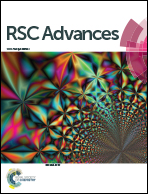Functionalized porous carbon with appropriate pore size distribution and open hole texture prepared by H2O2 and EDTA-2Na treatment of loofa sponge and its excellent performance for supercapacitors
Abstract
Activated porous carbon sheets, which have an appropriate pore size distribution and open hole texture, were prepared via the H2O2 and EDTA-2Na pre-treatment of a easily available biomass loofa sponge (LS) followed by carbonization and KOH-activation, and were employed as supercapacitor electrodes. Interestingly, it was observed that the specific surface area, surface heteroatoms content, and pore size distribution of the porous carbon were affected by the H2O2 and EDTA-2Na pre-treatment and KOH/C ratio. As the KOH/C ratio increased, the porosity development was broadened quickly and considerably under the micropore and a smaller mesopore within the range of 0.7–2.7 nm was obtained, indicating that there are no dividing walls among the variable sized pore framework and that an opened and interconnected channel texture was formed. The prepared hierarchical activated carbon possesses a high specific surface area (2402 m2 g−1) with reasonable pore size distributions and hence exhibits a good energy storage performance and high cycling stability. The supercapacitor based on LSAC-3, which was synthesized with the alkali to LSC ratio of 3, displays a remarkable electrochemical performance with a substantially high specific capacitance (up to 499 F g−1 at 0.1 A g−1) in 6 M KOH electrolyte, good rate capability (with a specific capacitance of 303 F g−1 at 10 A g−1), and extraordinary cycling stability (only 8.7% capacitance loss over 10 000 cycles at 5 A g−1). Moreover, the as-assembled symmetric supercapacitor delivers high gravimetric energy density of 25.3 W h kg−1 in 1 M SBP-BF4/AN electrolyte.


 Please wait while we load your content...
Please wait while we load your content...